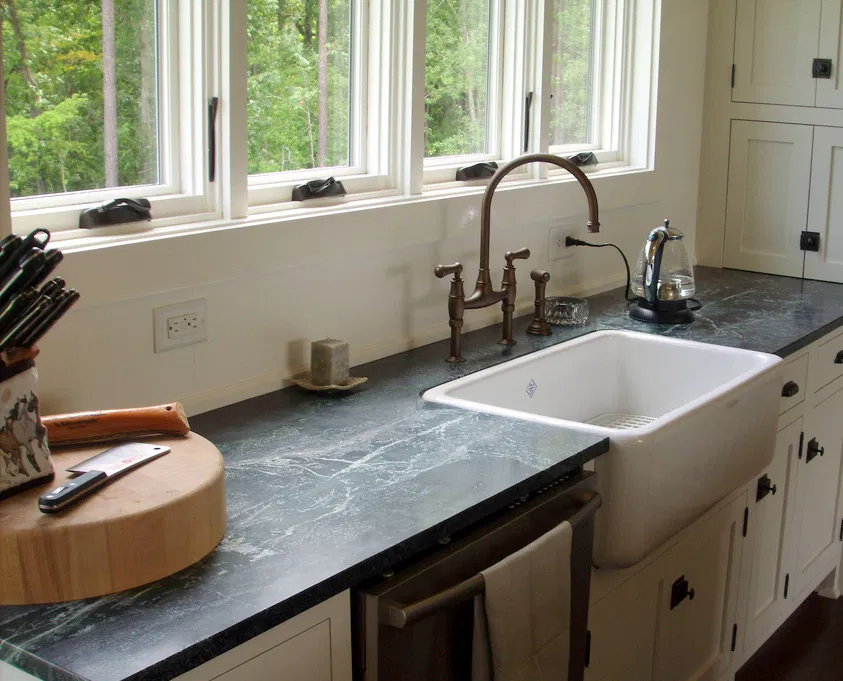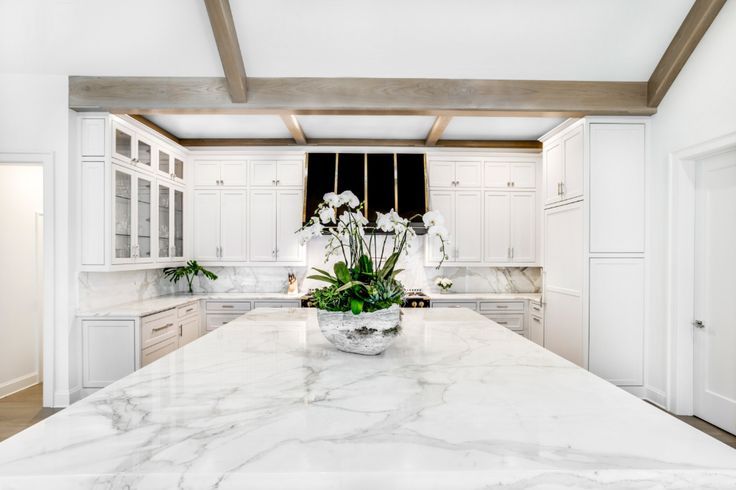Natural stone is a natural fit for a kitchen countertop – the perfect combination of timeless beauty and function. In this blog, we explore two natural stones: soapstone vs. marble countertops.
When it comes to kitchen remodels, most homeowners first think of granite and quartz as obvious first choices. In fact, a 2022 Houzz survey touts engineered quartz and granite as the most popular countertop materials – 42% and 24% respectively.
But there are other options for homeowners. Where do soapstone and marble fall in comparison to the others?
Many confuse soapstone with marble because they are both metamorphic rocks and on the softer end of the spectrum. However, these stones are in reality very different. To help you decide between the two distinct stones, we will cover the definitions and attributes of each.
Soapstone vs. Marble Countertops: Defined
Soapstone Countertops
Soapstone is a soft, metamorphic rock largely consisting of talc, described to have a “soapy” feel. Though it’s a soft rock, it’s known for its durability and resistance to stain, heat and acids.

Marble Countertops
Marble is a hard, crystalline metamorphic form of limestone. A softer material, marble requires more care to maintain its original luster.

Soapstone vs. Marble Countertop Comparison
Aesthetics
Soapstone naturally appears in a modest range of hues and is most available for countertops in light gray. This color deepens to a darker shade over time and achieves an antique look with greenish hues. For those that love a vintage look, this is a great plus. While soapstone is beautiful and ideal for those who favor a neutral and antique palette, the limited colors could be considered a drawback of the material.
Marble appears naturally in a wide range of colors – most commonly white but also available in green, blue, pink, red and black. It’s known for its elegant veining and can take a polish, making it a popular choice for luxurious designs. Similar to soapstone, marble develops a delicate patina over time.
Durability
A common misconception is that marble and soapstone are not ideal for kitchen countertops due to their softness. Even though they aren’t as durable as granite, they are still tough natural stones.
Soapstone looks soft, and some types of artistic soapstone can be very soap-like in durability. However, soapstone comes in grades and depends on the percentage of talc (the higher the talc percentage, the softer the stone). The type of soapstone used in kitchen countertops is about 30% talc, which is still quite hard. In addition, soapstone is stain and heat-resistant, unaffected by acid, and can be repaired in the case of any scratches or dents.
Marble is softer than other natural stones but in a similar durability range compared to soapstone – depending on the grade of the material. Usually, it’s harder than soapstone. The main difference? Marble is porous, while soapstone is non-porous. This means marble is more pervious to scratches and stains.
Maintenance
Because soapstone is non-porous, it does not require sealing. However, if you desire to achieve a darkened, antique look over time, you need to apply mineral oil to the surface periodically. If you do not oil the countertops, they will only darken where oil and other kitchen spills occur.
Since marble is on the softer side, it does require a little more care to maintain its original surface quality. It’s recommended to reseal periodically to help guard against any potential staining brought on by everyday use.
For both materials, it’s best to use only mild cleansers with a neutral pH, avoiding those with abrasives, ammonia or other harsh agents. Clean spills promptly, especially wine, juices and vinegar. Even though they are both heat resistant, coasters, trivets and cutting boards are recommended.
Price
Soapstone is limited in availability compared to other popular natural stones, which means it can be more expensive. In general, soapstone costs about $70 to $150 per square foot installed.
Marble also comes in a range of prices. More common types of marble can be somewhere between $65 to $85 per square foot, but exotic or rare marble types can cost up to $300.
Conclusion
Marble and soapstone are two distinct stones. However, they do have one thing in common: They are both beautiful options for countertops in lower-traffic areas.
Find timeless marble and soapstone countertop materials for your next project at Eastern Surfaces. Ask for more information on countertop materials by contacting us.



